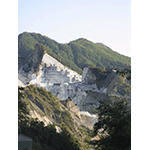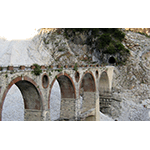The Roads of Marble

Thanks to the major quarries exploited since the mid I century B.C., Tuscany witnessed the formation of a veritable marble civilisation. This term indicates not only the refined and complex technology needed to extract and transport the enormous blocks, but also the society that for centuries has lived off of this precious resource.

The Historical Tradition of Marble
In the past, marble constituted one of the principal stone materials used in decorative and artistic apparatuses. In particular, in the Greco-Roman period, this material was one of the principal elements of production and economic activities. The archaeological evidence relative to Roman excavation, such as the Roman quarry at the Colonnata field, therefore proves interesting and of considerable importance.
During the Medici period, the marble industry received strong stimulus in Versilia. Seravezza, in particular, played an important strategic role in Medici politics, located as it was in the middle of an area rich in marble and iron fields. Michelangelo Buonarroti showed particular interest for the marble of the Apuane Alps, indeed valorising the marble fields of the spectacular Mount Altissimo.
Today, the mining area of the Apuane Alps represents one of the most important centres in the world for working this stone material, both in the building sector for architectural and decorative uses, and in the industrial ambit for chemical and glass industries.

The Places of Marble
The historical-cultural attraction and beauty of the landscape of the Apuane Alps render it a particularly fascinating location for a technical-scientific itinerary, which can also become the opportunity for an outing in nature. The marble area presents numerous and evident material signs tied to the activities of mining, working and commercialising this precious mineral resource.
Many marble quarries are situated between the provinces of Lucca and Massa-Carrara, delineating an extremely fascinating landscape facing the Versilia coast. From Mount Altissimo to the marble fields of Torano, Miseglia and Colonnata, it is a succession of quarries and vertiginous, white and shiny walls.
The impressive viaducts over Miseglia, the tunnel between Fantiscritti and Ravaccione, the bridges of Vara and the iron bridge of Vezzala are some of the testimonies of the old marble railway that started operating at the end of the 19th century and was retired in 1964. The railway made transporting marble more practical. Indeed, before it started operating, marble was transported by man by means of a complex operation of "sledding", wagons and drays pulled by oxen.
A small network of museums documents the work and popular customs tied to marble. Among these, worthy of mention are the Museum of Work and Popular Traditions of Historical Versilia, housed in the lovely Palazzo Mediceo in Seravezza, the "Luigi Bonacoscia" Ethnological Museum of the Apuane Alps in Massa and the Civic Museum of Marble in Carrara.
Also well worth visiting, to conclude the itinerary, are the numerous craftsmen’s workshops in Pietrasanta and the Museum of Drawings hosted in the porticoes of the former convent of Sant’Agostino, which contains the most significant plaster casts and preparatory drawings executed by the sculptors who worked, and still do, in the workshops of Versilia from the early 20th century until today.
Finally, not far from Pietrasanta lies the famous seaside resort of Forte dei Marmi, which owes its name to a marble warehouse where marble was collected awaiting to be loaded on "navicelli" (small boats). The warehouse is located in the vicinity of a fort built around 1788 by Grand Duke Peter Leopold.
-
 Ancient Marble Railway
Ancient Marble Railway -
 Marble Quarries of the Torano Field
Marble Quarries of the Torano Field -
 Marble Quarries of the Colonnata Field
Marble Quarries of the Colonnata Field -
 Marble Quarries of the Miseglia Field
Marble Quarries of the Miseglia Field -
 Marble Quarry of Mount Altissimo
Marble Quarry of Mount Altissimo -
 Museo Civico del Marmo [Civic Museum of Marble]
Museo Civico del Marmo [Civic Museum of Marble] -
 Museo Etnologico delle Apuane 'Luigi Bonacoscia' ['Luigi Bonacoscia' Ethnological Museum of the Apuanes]
Museo Etnologico delle Apuane 'Luigi Bonacoscia' ['Luigi Bonacoscia' Ethnological Museum of the Apuanes] -
 Palazzo Mediceo di Seravezza - Museo del Lavoro e delle Tradizioni Popolari della Versilia Storica [Palazzo Mediceo di Seravezza - Museum of Work and Folk Traditions in Historical Versilia]
Palazzo Mediceo di Seravezza - Museo del Lavoro e delle Tradizioni Popolari della Versilia Storica [Palazzo Mediceo di Seravezza - Museum of Work and Folk Traditions in Historical Versilia]
****************************
Texts by Graziano Magrini
English translation by Victor Beard
Last update 15/feb/2008


